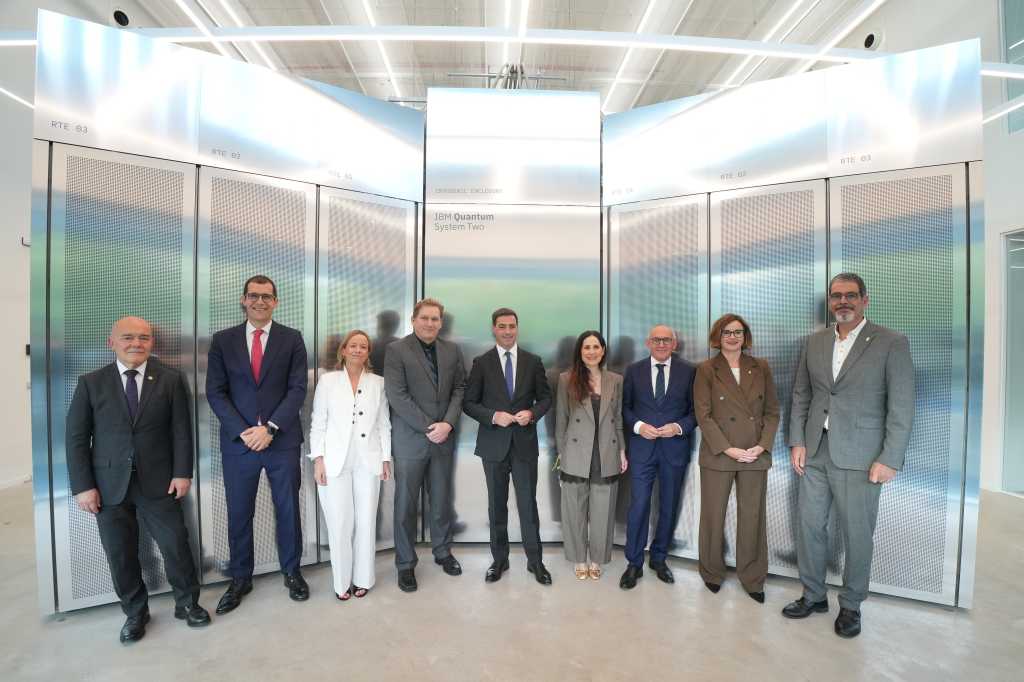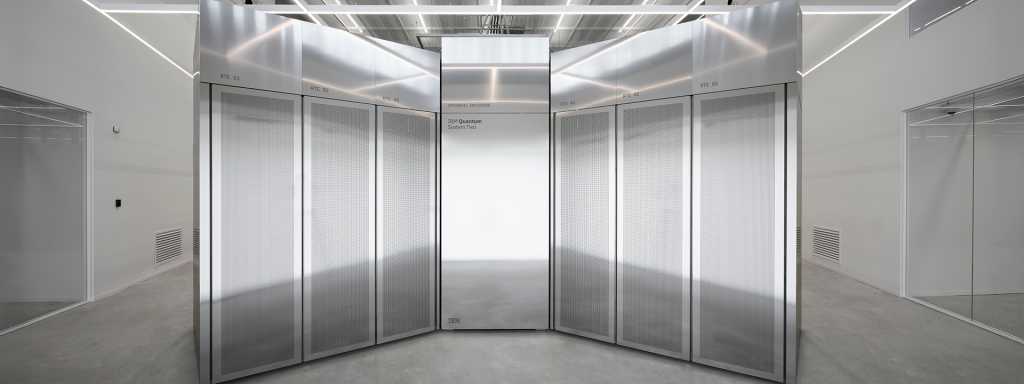The Guipuzcoan city of San Sebastián is now operating the IBM Quantum System Two quantum computer, the most advanced of its kind that IBM has developed commercially to date. This is the first installation of its kind in Europe and the second in the world—the first was installed in the Japanese city of Kobe before the summer—not counting the equipment IBM has in its own quantum labs in New York.
The IBM computer, which integrates a 156-qubit quantum chip (called Heron), is located in the new building of the Ikerbasque scientific foundation, which was also inaugurated on October 14, and from where the new equipment will be given access to more than 20 research centers and more than 30 companies, including the energy giant Iberdrola. All of them are attached to the Basque Quantum (BasQ) program promoted by the Basque Government, which includes an investment of more than 153 million euros in the promotion of quantum computing and science and an entire ecosystem designed to generate wealth and attract talent in the long term.
“Today is not just the inauguration of an extraordinary machine,” said Juan Ignacio Pérez Iglesias, Minister of Science, Universities and Innovation of the Basque Government, at the presentation of the new computer, held in San Sebastián. Computerworld attended the presentation at the invitation of IBM. “Behind this announcement is a whole strategy, working with scientific, technological and business stakeholders, and with the help of IBM, to develop an entire ecosystem around quantum computing.” For Pérez Iglesias, “this is a founding moment.” A vision shared by the Lehendakari himself, Imanol Pradales, who emphasized at the event that the regional government’s focus on “cultivating and preserving science for decades has been key to IBM choosing us as a partner and traveling companion among the dozens of offers they had in quantum computing.”
For the President of the Basque Government, the region’s quantum strategy (BasQ) “allows us to be a magnet for the generation of advanced knowledge and talent and also to align ourselves with the EU’s resilience and re-industrialization strategy.”
Quantum computing, classical computing, and AI
Jay Gambetta, current director of IBM Research and also present at the inauguration, emphasized that with this announcement, the company is “closer to the quantum advantage” it hopes to achieve by 2026, thanks, as Horacio Morell, president of IBM Spain, also pointed out, to the combination of new quantum computing with classical computing and artificial intelligence. “The combination of the three,” he asserted, “will allow us to tackle problems that have been intractable until now.”
After indicating that, thanks to this project, “quantum computing is becoming a reality in Spain today, and the focus will now be on translating it into applications and greater competitiveness for industry,” Morell reviewed the Blue Giant’s roadmap for this emerging technology, which, in addition to pursuing the aforementioned quantum advantage next year, also aims to launch the first commercial quantum computer on a scale and capable of error correction, i.e., without the famous quantum “noise,” on the market in 2029. “In addition to placing us [as a country] on the quantum computing map, this project will be a legacy for our society,” he noted.

IBM executives and officials from the Basque Government and regional councils in front of Europe’s first IBM Quantum System Two, located at the IBM-Euskadi Quantum Computational Center in San Sebastián, Spain.
Irekia
Adolfo Morais, Deputy Minister of Science and Innovation of the Basque Government, explained to the press present at the event that the use of the new quantum machine in combination with other classical supercomputing systems, which will be modernized shortly, and artificial intelligence solutions will surely be a reality in 2027. “At the Euskadi Quantum Computational Center of Ikerbasque, we are already thinking about setting up a more modern supercomputer to replace the current Hyperion next year, so that in two years we will be able to use the three types of technology in combination.”
“We don’t envision quantum computing working independently, just as we don’t envision classical computing working independently in the future,” emphasized Mikel Díez, director of Quantum Computing at IBM Spain, confirming that the new computer works in conjunction with classical computing architecture. “The purpose of our quantum computing proposal is for it to work in conjunction with classical computing,” he emphasized.
The machine, he explained, is a modular architecture that, for now, has a single quantum chip, but more can be added. It takes up almost an entire room and must be kept at a temperature of -273 degrees Celsius, guaranteed by a pump cooling system. “It consumes kilowatts, not megawatts, because the qubits barely require any energy; in this sense, it’s very different from large classical supercomputers, which require much more energy,” Díez added.
Practical applications of an emerging technology
Quantum computing, combined with classical supercomputing and increasingly powerful AI tools, is expected to disrupt not only the academic world but also various productive sectors. As Mikel Díaz himself recalls in an interview with Computerworld, the Basque Government’s BasQ program contemplates three types of initiatives or projects that will work with quantum technology. “The first are related to the evolution of quantum technology itself: how to continue improving error correction, how to identify components of quantum computers, and how to optimize both these and the performance of these devices.”
In this sense, as Díez himself acknowledges to this newspaper, “it’s true that the computer we’re inaugurating today in San Sebastián is a ‘noisy’ computer, and this, in some ways, still limits certain features.” Specifically, according to the IBM executive, the Quantum System Two has a rate of one error per thousand operations performed with a qubit. “Although it’s a very, very small rate, we’re aware that it can lead to situations where the result isn’t entirely guaranteed. What are we doing at this current moment? Post-processing the results we obtain and correcting possible errors.” Díez emphasizes that this will be done for the duration of this transition period until the arrival of a fault-tolerant quantum machine, as classical computers have been for years.
Another type of project to which quantum computing will be applied, from a more scientific perspective, is the behavior of materials or time crystals. Finally, he explains, there is a third line related to the application of this technology in industry. “For example, we are exploring how to improve investment portfolios for the banking sector, optimize the energy grid, or explore logistics problems.”

The Basque Government and IBM unveil the first IBM Quantum System Two in Europe at the IBM-Euskadi Quantum Computational Center in San Sebastián, Spain.
IBM
Currently, according to Adolfo Morais of the Basque Government, “50% of the quantum computing capacity is already being used by the scientific sector. We hope that the remaining 50% will be used by other scientific institutions, as well as by private companies and public bodies.” Along these lines, he added, both the three provincial councils and the Basque Executive have programs to accelerate use cases. “We not only want to attract Basque companies and entities, but the project has a global scope. In the coming weeks, we will announce how to apply for access to these quantum services,” he stated, emphasizing that the selection of projects will be based on their quality.
Morais also emphasized that the collaborative framework between Ikerbasque and IBM has never been about “merely acquiring a device.” The contract, which amounts to €80 million—the figure initially announced was over €50 million—includes the acquisition of the quantum computer, “the most expensive component,” but also the implementation of other research and training initiatives. In fact, thanks to this agreement, 150 people have already been trained in this technology.
This feature originally appeared on Computerworld Spain.
🛸 Recommended Intelligence Resource
As UAP researchers and tech enthusiasts, we’re always seeking tools and resources to enhance our investigations and stay ahead of emerging technologies. Check out this resource that fellow researchers have found valuable.

Leave a Reply